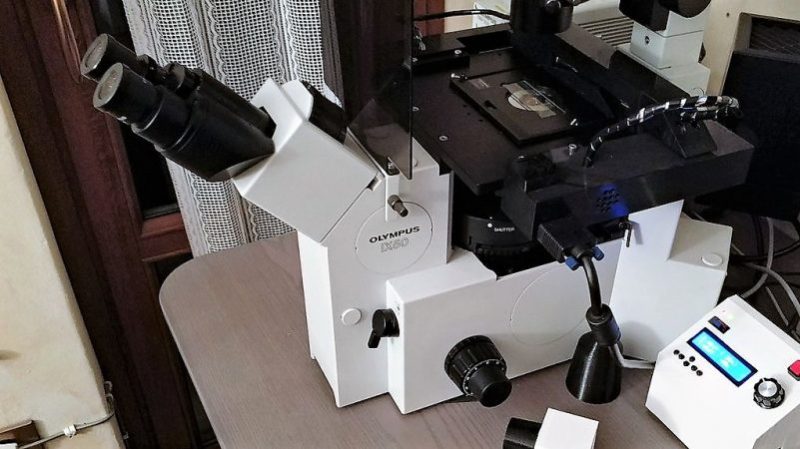No matter how fine your fine motor skills may be, it’s really hard to manipulate anything on the stage of a microscope with any kind of accuracy. One jitter or caffeine-induced tremor means the feature of interest on the sample you’re looking at shoots off out of the field of view, and getting back to where you were is a tedious matter of trial and error.
Mechanical help on the microscope stage is nice, and electromechanical help is even better, but a DIY fully motorized microscope stage with complete motion control is the way to go for the serious microscopist on a budget. Granted, not too many people are in [fabiorinaldus]’ position of having a swell microscope like the Olympus IX50, and those that do probably work for an outfit that can afford all the bells and whistles. But this home-brew stage ticks off all the boxes on design and execution. The slide is moved across the stage in two dimensions with small NEMA-8 steppers and microstepping controllers connected to two linear drives that are almost completely 3D-printed. The final resolution on the drives is an insane 0.000027344 mm. An Arduino lives in the custom-built control box and a control pad with joystick, buttons, and an OLED display allow the stage to return to set positions of interest. It’s really quite a build.
We’ve featured a lot of microscope hacks before, most of them concerning the reflective inspection scopes we all seem to covet for SMD work. But that doesn’t mean we haven’t shown love for optical scopes before, and electron microscopes have popped up a time or two as well.
















You couldn’t have just written 27.344 nm?
Also, there is no way you are actually getting that resolution. Hell, I’d be impressed if you even managed to get 1 micrometer resolution.
There may be 27nm resolution, but I would guess positional accuracy is more of the close order of 10 to 20 micrometers. Repeatability and incremental accuracy may be an order of magnitude better (which are is what really matter). The screws used are not precision (they are anchor rod) limiting absolute accuracy, there is going to be flex due to the off center drive (single screw), and stiction as well, limiting repeatability and incremental precision.
A very nice design for a homebrew, and well executed.
simple stepper can have 2-3um accuracy so I believe in that claim.
https://www.youtube.com/watch?v=o4PX10Hz9x4
ok, correction, I saw pictures, there is no chance is accurate with that arrangement, with no stepper reduction and this flexible coupler.
This design is terrible, no axial restraint of the screws. The rolled screws are just floating between the bearing and the helical coupler. at least if he used solid couplers he would have had a little restraint with the motor’s bearings. And those linear ball bearings are almost useless for accurate work, especially at the scale he is working at.
Looks like a fun little project. Too bad it uses fans mounted on the stage. There must be a way to arrange the motors so they can be convection-cooled and not require the noise and breeze and vibration of a pair of fans. Kind of defeats the objective of having super-fine position control.
And, yeah, no way it that motor microstep size of 27 nm every going to be real position resolution, and certainly not repeatability. He’ll be lucky to get a half (real) step of repeatability: about 2 microns in his case.
I can see a real use for this in automated pan-and-stitch for really big micrographs. Put it on the Z axis too, to do focus stacking.
Totally agree. Even 2 microns resolution would be a great achievement. It would probably require fancy hw & sw anti-backlash and axes mapping alignment. That would require high precision sample with grid lines. On the other hand, why would optical positioning system need resolution beyond that? I would rather care about vibration isolation.
Not happening. Microstepping does somewhat increase resolution, somewhat because a stepper motor does not always even move during a microstep, so they really only have accuracy at the full step location and anything in between is really unknown unless you throw an encoder on it.
This clearly needs some laser interferometers working in a servo loop with geared down motors to get more precision…
.. and 0.1C temperature control of the local environment.
I love you for mentioning temperature!